6 SMS marketing use cases and 11 examples to boost engagement and revenue

When Ohio-based apparel brand HOMAGE launched their first SMS campaign to promote the release of their 80s- and 90s-style NFL Starter jackets, they drummed up 100 orders in the first hour alone.
Ultimately, 87% of SMS customers clicked the in-message link, and 9% of fans placed an order. Even more impressive: The campaign delivered $167 in revenue per recipient (RPR).
Those numbers aren’t representative of all SMS campaigns. In fact, they’re miles above average—according to Klaviyo’s latest benchmarks report, SMS campaigns drive, on average, 5.76% click rates and $0.11 in RPR.
But in a data privacy-forward world, HOMAGE’s numbers do show just how impactful SMS can be as a marketing channel—for the ecommerce brands that know how to use it right.
Why is SMS marketing important for brands?
Here are just a few benefits of SMS marketing:
- SMS has one big advantage over email marketing: it gives you direct access to your subscribers’ most personal devices. This means any time-sensitive promotion reaches your people where—and when—it matters most.
- Character limits force concise messaging—always a plus in an attention-scarce world.
- SMS can create a sense of urgency that other channels struggle to match.
- SMS plays nice with your other marketing channels, like email and push notifications. It’s a crucial component of an omnichannel marketing strategy.
- SMS marketing requires explicit consent, which means you always know your audience wants to be there.
SMS marketing examples from real-life brands
1. Promote product launches, sales, and discounts
Email is a strong marketing channel because it drives high-intent traffic to your site at a low cost. But SMS campaigns built around product launches, holidays, offers, and price changes can help generate incremental revenue and customer engagement, too.
Sending promotional text message campaigns to your customers or subscribers, in addition to email, will likely increase your overall performance.
“Promotional messages are large revenue drivers for SMS,” says Emma O’Rourke, email and SMS marketing manager/copywriter at CURIO Agency. “People check their text messages more quickly and frequently than they check their email, so it’s convenient for subscribers to hear about sales and new products directly through text and have the ability to quickly purchase right away.”
Jen Brennan, director of digital marketing at Northern, observes that flash sales, in particular, “are great SMS ‘rope drops.’ So many subscribers will see the message and action it well before they see an email and possibly miss out on a limited-time offer.”
SMS use case: promotional SMS campaigns from real-life brands
This promotional text from microdrink brand waterdrop® is an SMS use case worth taking a closer look at. Personalized with the recipient’s first name, and gets straight to the point introducing the specs of a new product line.
Instead of relying on a discount code to promote the new product, waterdrop offers a simple reminder that shipping is free after $20.
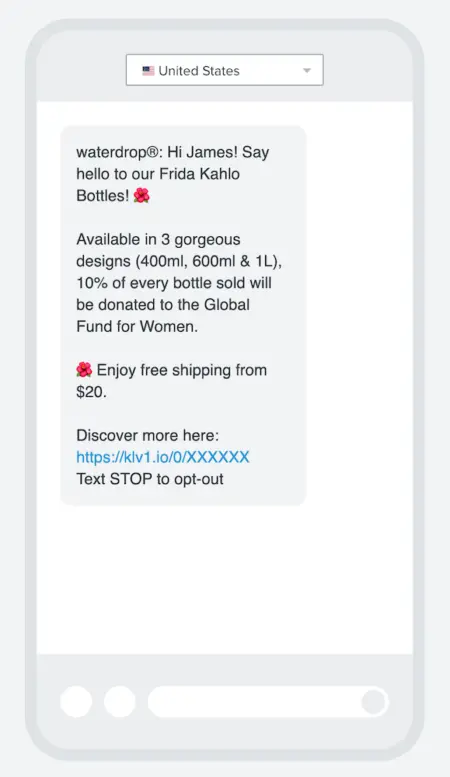
Similarly, in this promotional text for a new line of body wash, clean beauty brand Each & Every makes the most of the higher character count of an MMS by pairing playful emojis with a beautiful, specific product image.

2. Coax abandoners back to their shopping sessions
Visitors who come to your site and browse the same product multiple times show high intent to purchase. And visitors who add a product to their cart but don’t purchase show even higher intent to purchase.
Even if you’re already using email to prompt those shoppers to take the final plunge, incorporating SMS into your existing flows could help you increase your conversion rates even more.
Unless the subscriber has consented to receive only email or only SMS, most of the flows at ethical jewelry brand Dana Rebecca Designs are hybrid, says Blair Peterson, VP of strategy. “If they’re an SMS subscriber, the first touchpoint is coming to SMS vs. email, and that’s where we’ve seen a greater return,” she explains.
In fact, the brand’s cart abandonment flow consistently earns the highest engagement from subscribers. “In the beginning, SMS was the second or third touchpoint within the flow. But we see a higher conversion rate from being able to send the reminder directly to the customer’s fingertips,” Peterson explains.
The team at ecommerce growth marketing agency Homestead Studio sets up hybrid email and SMS flows in Klaviyo by using conditional splits and time delays. “If someone’s getting a text, we want to delay that maybe 2-3 hours after the email, and then delay another day until the next email,” explains Jacob Sappington, head of email.
Similarly, you want to filter out anyone who recently made a purchase, or who has a history of not engaging with SMS—even if they’re still subscribed to the channel.
“Sending to disengaged audiences or those who have purchased within the last X hours is only going to hurt your KPIs,” cautions Kelly Cunningham, senior retention manager at Fireside Digital.
SMS use case: SMS abandonment flow from a real-life brand
Many ecommerce brands believe they need to include a promo code in their abandonment flows in order to drive conversions. But this example from Zend Coffee proves that’s not true.
Notice how the coffee brand uses simple, on-brand copy, a beautiful product image, and a prominent CTA to remind the subscriber of the product they intended to buy. No discount necessary.
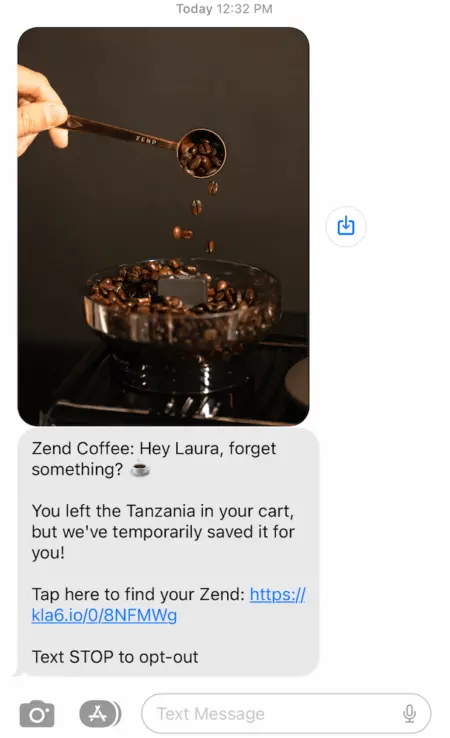
3. Keep recent buyers in the know
According to Klaviyo’s SMS consumer sentiment report, the top types of text messages consumers want to receive more often from brands include transactional text messages like delivery, shipment, and order confirmations.
But many brands are missing out on leveraging SMS within transactional flows, observes Alex Klein, VP of consumer engagement at 85SIXTY.
“lt’s not usually thought of as a revenue-driving tactic, because at the goal level, it’s not,” Klein says. “In reality, the increased engagement you get typically results in increased incremental revenue—which drives tangible business results.”
“Transactional messages are underutilized in SMS,” agrees Katherine Burlock, senior account strategist at &BAM. “I personally love getting a text that lets me know my delivery is on its way or is waiting on my porch. It also gets the subscriber used to hearing from you—and, more importantly, wanting to hear from you.”
Ashley Ismailovski, director of email marketing at SmartSites, adds that transactional texts help prevent “common issues like repetitive inquiries about package status, missed deliveries, package theft, and more”—and also “give brands an easy way to follow up with customers post-purchase to ask about their experience, request a review, or suggest recommended products.”
Rob Hand, former lead product marketing manager at Klaviyo, adds that transactional texts are particularly important for warming up new customers.
“Sending proactive updates about their order puts customers at ease and builds trust,” Hand explains. “You’re building a strong relationship right out of the gate, and that’s really important in ecommerce where we can’t see, touch, or feel a product in real life before buying.”
SMS use case: text message order notification from a real-life brand
In this SMS marketing example of an order confirmation text from premium skincare brand Hello Skincare, the brand does more than just confirm the recipient’s purchase. They also include a cute image to build excitement, encourage the recipient to take progress photos, and share their social media link so that the subscriber can stay connected on other channels.
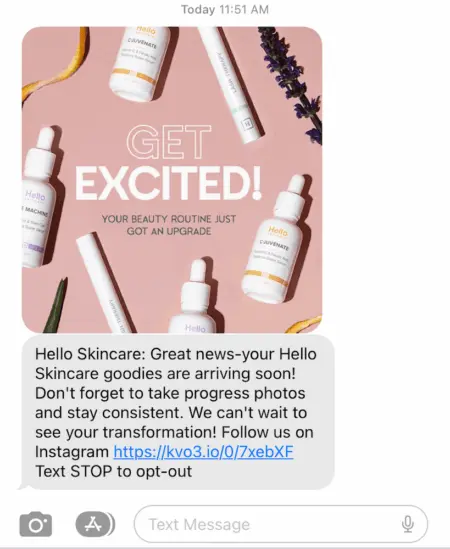
Here, Hello Skincare does a great job following this advice from Fiona Stevens, head of marketing at LoyaltyLion, on how to improve the performance of post-purchase SMS messages: “Take the opportunity to remind customers of the ways they can interact with your brand in between purchases. Tell them where to find you on social media, tell them how to create a loyalty account, and tell them how to find your content.”
4. Nurture your post-purchase customer relationships
On that note, post-purchase SMS messages “are a great time to get the flywheel going and re-engage existing customers to queue up their next purchase,” observes Sharon Goldstein, CEO of LimeSpot.
“Many brands use SMS as a microphone for newness and promotions, but it’s also a great tool for targeted up-sells and cross-sells,” agrees Loretta Doria, senior strategist at Ragnarok. For example: “You know what would go great with that couch? This rug!” “You got the bathing suit—now complete the look with these sunnies!”
“You get the idea,” Doria says. “Prompting and inspiring customers to their next most likely purchase in a specific way can be more effective than general marketing blasts.”
But post-purchase SMS is also a prime opportunity for non-promotional communication with your new and repeat customers. As you build out your SMS subscriber list, “it provides the opportunity to really interact with customers and use SMS in a more fun way,” says Elliot Scott, founder and CEO of London-based retention agency ElliotDigital.
“It’s asking questions, it’s requesting user-generated content (UGC), it’s playing games with them—it’s just building community,” Scott explains. “I think that’s what a lot of brands are missing out on is that community element.”
“Brands have to send more community-building SMS messages,” agrees Mollie Woolnough-Rai, senior marketing manager, Penny Black. “Whether that’s to just check in with the customer, share some exciting content the brand has just dropped, or spotlight other members of their community, this will make sure that customers don’t just think the brand is reaching out for a transactional relationship.”
That could erode trust, Woolnough-Rai points out. By contrast, “brands that adapt their SMS strategy to emotionally connect will show customers they care about them on a personal level, ultimately building long-term customer loyalty.”
SMS use cases: post-purchase nurture texts from real-life brands
Consider this great example from Leggari Products, LLC, a brand that aims “to sell the industry’s most durable and user-friendly epoxy products while providing the industry’s most user-friendly installation.”
In this educational text, Leggari celebrates “DIY Sunday” and shares a link to help subscribers resurface their old countertops—no purchase required.
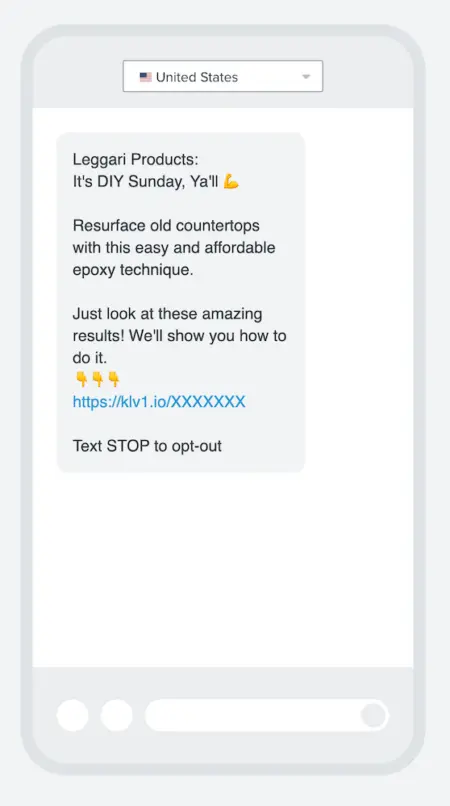
Sparkling water brand Aura Bora takes a similar approach with this post-purchase MMS text, sharing a recipe for a homemade drink called the “Spiked Cactus” SMS subscribers can make at home—using Aura Bora ingredients, of course.

Here’s one last fun example from Pizzamas—a two-week annual event that is “equal parts fundraiser and celebration of community, with a healthy dose of absurdity and nostalgia,” according to Good Good Good.
For a brand that started as a niche internet joke, an SMS marketing strategy centered on daily jokes is a perfect fit. And after the joke, the text doesn’t try to pivot into making a sale—it just encourages subscribers to stay connected to the Pizzamas online community.

5. Build long-term loyalty by asking for feedback
Compared to email, SMS is also a more intuitive channel for actually interacting with your subscribers. Most people won’t reply to an email they receive from a brand, but that’s not true for SMS—one of its primary differentiators as a channel is that it allows businesses to communicate directly with subscribers, in real-time conversations.
To promote a positive customer experience in the long term, consider using conversational SMS to ask your customers if they have any questions or suggestions regarding your products or the way your brand is doing business.
“A lot of brands should be doing that more—asking for feedback,” Scott says. “Take that more personal approach. ‘Hey, I wanted to introduce myself. I’m the community manager of XYZ Brand, if you have any questions, let me know.’”
Stevens puts it this way: “The more ways you can show subscribers how to connect with you after their first purchase, the more likely you are to secure the next—and enjoy a longer-term relationship with your customers.”
SMS use case: feedback request text from a real-life brand
Even if you don’t have the ability to respond to subscriber inquiries via text, you can still use SMS as a channel for soliciting feedback from your customers. In this post-purchase text, organic skincare brand Essentially Haitos shares a survey link encouraging the recipient to share feedback about their experience with the brand.
After greeting the recipient by their first name, the text expresses a human desire to learn more about their customers—and anticipates customer needs by promising the survey will take only 5 minutes to complete.

6. Treat your best customers like the VIPs they are
Scott’s agency primarily uses SMS as a VIP channel. “We push it as a channel to sign up for early access,” he explains. “It’s not always a discount, it’s not always the biggest deals, but whatever it is, you hear about it first.”
Dana Rebecca Designs loves the early-access approach, Peterson says. “We are not a discount- or promotion-heavy brand,” she explains. “Our strategy is more around, ‘We’re moving new product into the sale section on Friday, but an SMS subscriber would find out on Thursday.’ Or, ‘We have a new product launch—get access a day ahead via SMS.’”
Exclusive content, upgraded discounts, behind-the-scenes sneak peeks, and first dibs on special sales, back-in-stock inventory, and limited-edition products are all great ways to make an SMS subscription worth a VIP’s while, Benjamin says Cassie Benjamin, email/SMS channel manager at Tadpull.
“They’re getting the discounts first, they’re getting responses quicker, and they’re the ones who’re hearing about new or limited-edition products,” Scott explains. “That way, they know we’re thinking about them. That makes them feel like they’re in a channel that’s worth it for them.”
In sum, Peterson says, it’s about sharing “small perks that make them feel exclusive and stay engaged.”
Ben Zettler, founder of Zettler Digital, emphasizes the importance of keeping this type of messaging exclusive. “For very rare sales or product releases, brands I manage give truly exclusive windows of access to their SMS subscribers. We promote getting on the SMS list via email and social, but we make sure to keep the actual access exclusive to SMS,” he says. “And we’ve driven some massive volume.”
“It’s important to keep your word on that exclusivity,” Zettler says. “When brands announce this kind of exclusive access and then open up the sale to email and social quickly, I’ve seen it backfire.”
SMS use case: VIP texts from real-life brands
This text from premium skincare brand Rebels Refinery accomplishes exactly that. It’s clear from the very first line that the recipient is getting something special—the words “early drop” plus “VIP” are a one-two punch that make the subscriber feel like they’re getting in on something exclusive before they even open up the notification to read more.

Or consider this early-access reminder, in which kids’ clothing brand Cheeky Chickadee combines a brand-positive greeting with short, direct copy to invite SMS subscribers to access their new fall collection early. The inclusion of a secret password makes the invitation even more enticing:
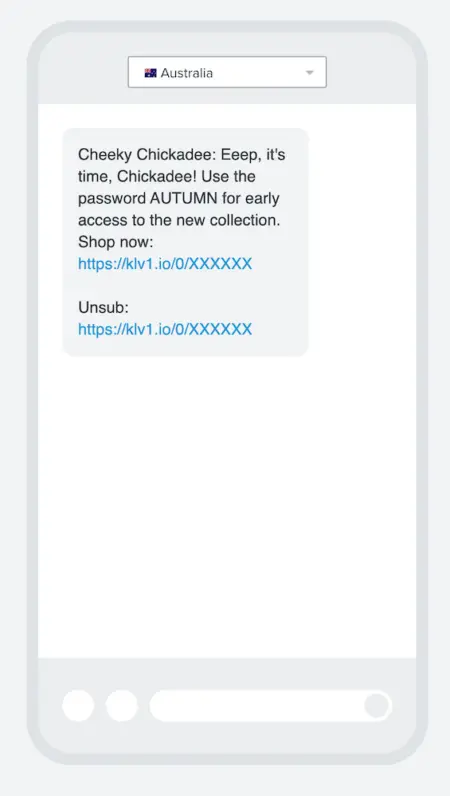
We’ll leave you with this strong example from The Peach Truck, a Tennessee-based fruit subscription brand whose mission emphasizes buying local. This colorful MMS message does several things to make the recipient feel special and connected to the brand:
- It’s personalized with both the recipient’s name and the sender’s.
- It reminds the recipient of their VIP status above the fold.
- It provides details on an exclusive new product that’s available for a limited time—it’s a special, seasonal fruit, one of the juiciest varieties of oranges, and it’s only harvested for a few weeks a year.

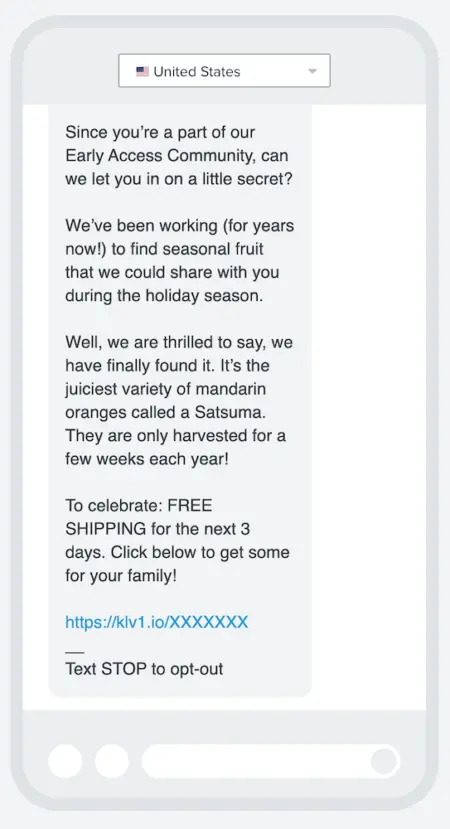
Getting started with SMS marketing
If you’re ready to launch your SMS marketing program, here are a few best practices to keep in mind:
- Choose a reliable SMS marketing platform with automation and analytics capabilities.
- Collect explicit consent for SMS marketing through sign-up forms, keyword texting campaigns, and collecting phone numbers at check-out.
- Segment your audience based on demographics, purchase habits and history, or engagement level to make sure you’re sending relevant messaging that resonates.
- Keep messages concise. Less than 160 characters is standard, but the limit can vary by region or when you use emojis or non-Latin letters.
- Study SMS marketing examples like those detailed in this blog for inspiration.
- A/B test different send times and message variations to see what earns you the highest open and conversion rates.
Klaviyo, the CRM built for B2C, brings data, marketing, and service apps together with a complete set of channels—email, SMS, mobile, WhatsApp, and ad orchestration—into one unified platform. This seamless integration means you can manage every aspect of your customer relationships in one place, including SMS marketing that actually moves the needle.

Related content

Looking for the best SMS marketing tools? See the top 3 platforms for 2026 and learn how to choose the right one for segmentation, automation, and two-way messaging

Marketers are right to be cautious right now. The Texas settlement has sparked more questions than clarity—but that’s exactly why taking a compliance-first approach still matters.
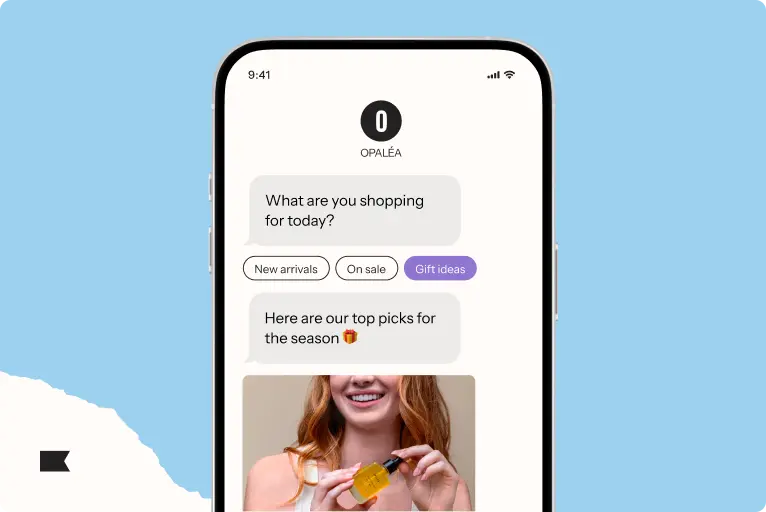
Google’s RCS Roadshow and Klaviyo are shaping the future of mobile marketing with AI-powered personalization and trusted, interactive messaging.